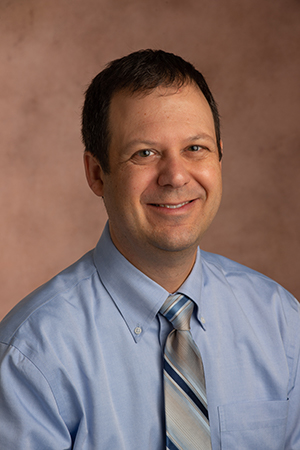
For two years now, a research project led by Erik Larson, PhD, has sought to pinpoint the molecular events that cause autosomal dominant polycystic kidney disease (PKD).
The work – understanding more about the root cause of PKD – could one day lead to new gene-specific drugs that assist in diagnosing or lowering the risk of developing a disease that affects one out of every 500 people in the U.S., Dr. Larson said.
Now, Dr. Larson’s research project, “Guanine-Quadruplex DNA and Polycystic Kidney Disease,” has been infused by a three-year, $340,000 R15 grant that was awarded to WMed in August by the National Institute of Diabetes and Digestive and Kidney Diseases (NIDDK), which is part of the National Institutes of Health (NIH).
“Our hypothesis is that unusual DNA structures form in the PKD1 gene, which causes the gene to become inactivated,” said Dr. Larson, who is an associate professor in the medical school’s Department of Biomedical Sciences. “This grant will allow us to test that hypothesis to understand what causes PKD.”
Dr. Larson’s examination of what kind of DNA sequences cause genetic instability in PKD began shortly after his arrival to WMed in 2017 through interactions with Greg Vanden Heuvel, PhD, a professor in the Department of Biomedical Sciences who has worked for more than 30 years on research to stem the deadly effects of PKD.
PKD is a developmental disease that begins in utero and gets progressively worse throughout life as nephrons in the kidneys balloon out instead of elongating properly. The disease causes eight to 10 percent of all cases of end-stage renal failure and medical care for patients with PKD comes with a price tag that averages $2 billion per year in the U.S.
Dr. Larson called his collaboration with Dr. Vanden Heuvel after arriving at WMed “serendipitous.” While PKD researchers, including Dr. Vanden Heuvel, have determined that PKD is caused by gene inactivation, the answer as to why the gene inactivation occurs has remained elusive. Now, with his expertise in genetics and DNA structures, Dr. Larson said he is excited to delve into why the gene inactivation that causes PKD occurs in the first place.
“When you recognize that something is common between two otherwise unrelated areas of research, you can then make a leap forward” Dr. Larson said. “It was serendipitous. My particular area of expertise fits perfectly with what’s going on with PKD1. I think we can make an impact in the field together that we wouldn’t be able to do separately.”
“My interests are aligned with understanding the mechanisms of gene inactivation,” Dr. Larson added. “If you look at the DNA sequence, the answer is right there in front of you if you know what to look for.”
The new funding for Dr. Larson’s project is the first R15 grant received by WMed since the medical school was founded in 2012. The awar is also significant as the R15 grant mechanism requires that students be involved in the important research that will take place in Dr. Larson’s lab at the medical school’s W.E. Upjohn M.D. Campus.
“I like working with students in the lab and that’s an important part of what I want to do in genetics,” said Dr. Larson, who is the previous recipient of two NIH R15 grants and has co-authored research publications with more than 40 students throughout his career.
Dr. Larson said the grant funding from the NIDDK was bolstered by his research of PKD that began as part of the Pilot Research Project Support Program at WMed. The program was implemented at the medical school in 2017 to support internal research at the medical school with the aim of engaging students and residents in projects with the potential to garner extramural funding.
Dr. Larson said his PKD research project was awarded $8,900 and $3,000 by the pilot research project support program in 2017 and 2018, respectively.
“The pilot project funding really helped build the rationale for the project with the NIDDK,” Dr. Larson said. “Those funds moved the project forward, and got our medical students involved in the research.”
Dr. Larson said the grant from the NIDDK will help fund a position for a researcher in his lab to increase momentum on the project and allow medical students to assist with the research on a larger scale than before.
